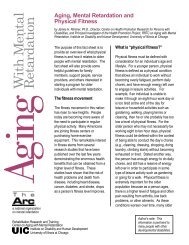Bridging the Aging and Developmental Disabilities Service ... - rrtcadd
Bridging the Aging and Developmental Disabilities Service ... - rrtcadd
Bridging the Aging and Developmental Disabilities Service ... - rrtcadd
Create successful ePaper yourself
Turn your PDF publications into a flip-book with our unique Google optimized e-Paper software.
When <strong>the</strong> ADRC was implemented under <strong>the</strong> previous administration it was<br />
not conceptually well thought out.<br />
• ADRCs are a process not a center. ADRCs were initially conceptualized as single points of<br />
entry for long term supports <strong>and</strong> services for people with disabilities who are aging <strong>and</strong><br />
people aging into disability. ADRCs were reconceptualized as <strong>the</strong> “No Wrong Door”<br />
approach because each population has unique needs <strong>and</strong> is oriented towards different<br />
philosophies of service. Consequently, each ADRC partner agency is autonomous <strong>and</strong><br />
operates largely as “business as usual”.<br />
• Br<strong>and</strong>ing for ADRCs has never been uniformly established or implemented, which results<br />
in confusion for staff <strong>and</strong> consumers.<br />
The ADRC program has been operating for eight years with limited<br />
collaboration between <strong>the</strong> aging <strong>and</strong> DD networks.<br />
• AoA envisioned <strong>the</strong> national ADRC network eventually would serve all people with<br />
disabilities. However, AoA has not supported partnering with <strong>the</strong> DD network as <strong>the</strong> ADRCs<br />
exp<strong>and</strong>ed nationally. Less than half (42%) of <strong>the</strong> 365 local ADRCs served people with<br />
developmental disabilities during <strong>the</strong> six month period ending March 31, 2011. By<br />
comparison, 213 ADRCs partner with Centers for Independent Living (CILs), <strong>and</strong> CILs are<br />
<strong>the</strong> lead agencies at 93 of <strong>the</strong>se locations (NCIL, 2011). Nine out of ten people with<br />
developmental disabilities that <strong>the</strong> ADRCs served were concentrated in just six states.<br />
• Funding announcements for grant applications to exp<strong>and</strong> <strong>and</strong> enhance ADRCs do not<br />
require, or even suggest, that awards be used to include individuals with developmental<br />
disabilities as a target population, even though RFPs specify that “Grantees are required to<br />
serve adults 60 years of age <strong>and</strong> older <strong>and</strong> at least one o<strong>the</strong>r target population of younger<br />
individuals with disabilities in at least one community at all income levels.” 47<br />
• AoA does not include <strong>the</strong> imagery of people with developmental disabilities on ADRC<br />
brochures <strong>and</strong> websites to demonstrate that ADRCs serve this population. Figure A, from<br />
Georgia’s ADRC brochure, is an example of how imagery can be used to convey that<br />
ADRCs serve people with developmental disabilities.<br />
• There is a predisposition for AAAs to collaborate with CILs because both primarily serve<br />
people with physical <strong>and</strong> sensory disabilities. CMS is encouraging states to use <strong>the</strong> same<br />
functional assessment tool across populations <strong>and</strong> some states serve both older adults <strong>and</strong><br />
younger adults with physical disabilities under <strong>the</strong> same 1915 “c” Medicaid waiver.<br />
<strong>Bridging</strong> <strong>the</strong> <strong>Aging</strong> <strong>and</strong> <strong>Developmental</strong> <strong>Disabilities</strong> <strong>Service</strong> Networks Page 42



